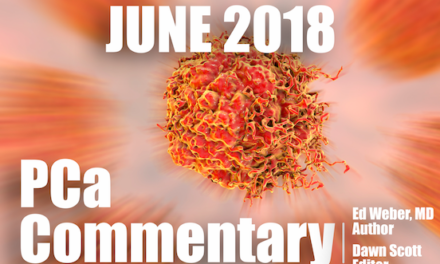
PCa Commentary | Volume 169 – September 2022
Posted by Edward Weber | September 2022
ANDROGEN DEPRIVATION THERAPY (ADT) AND RADIOTHERAPY: Basic Mechanisms and New Developments.
Any man diagnosed with prostate cancer is likely aware that lowering testosterone (T) levels achieves control of the cancer at various stages of the disease. Question: What is the underlying biology and function of that therapeutic maneuver (androgen deprivation therapy; ADT).
“Neo-adjuvant” ADT: Refers to T reduction prior to initial radiation therapy. (T reduction has not proven useful prior to prostatectomy.)
- ADT Prior To Brachytherapy:
The purpose of ADT prior to brachytherapy is straightforward: Lowering T reduces the size of prostate gland by 30% over about a 1-month period and facilitates the passage of brachytherapy needles past a potentially obstructing pubic arch. This ADT is conventionally accomplished with Lupron, degarelix or dutasteride/casodex and usually precedes radiation by about 2 months. - ADT Administered Prior To and During Radiotherapy:
ADT potentiates the lethality of radiation. Radiation inflicts double stranded DNA breaks in cells and these breaks become lethally operative when the cell attempts to proliferate by cell division (mitoses). ADT assists radiation effectiveness by inhibiting the repair of the damaged DNA and is continued during the full course of radiation so as to continue the potentiation as the ongoing radiation induced DNA damage is sequentially delivered.
“Adjuvant ADT” — Refers to the continuation of ADT for variable durations after the completion of radiation.
During the course of neoadjuvant and adjuvant ADT the PSA drops due to the acute death of 90+% of prostate cancer cells because of their dependence on T for life-support. Adjuvant ADT has been extensively studied over many years and has consistently been found to improve patient overall survival as compared to no ADT in men with unfavorable intermediate-risk and high-risk cancer.
ADT has been customarily achieved with Lupron or Firmagon, but the current availability of Orgovyx (relugolix) is leading to potential changes in the use of ADT with radiation therapy.
Relugolix, ADT and Radiation Therapy (RT):
A comprehensive critical review of this subject was offered by Spratt, Roy and colleagues,
“An Expert Review on the Combination of Relugolix with Definitive Radiation Therapy for Prostate Cancer,” Rad Oncol Biol Physics, Oct 2021.
Spratt points out that “Relugolix achieves faster, and more complete, testosterone suppression compared with the LHRH agonist Lupron and may require physicians to rethink the mechanism and goals of ADT when prescribing.” In the HERO study by 4 days relugolix reduced the T levels to below 50 ng/dL (castrate level) in 56% of men vs 0% with Lupron; and by day 15 T was reduced by 98.7% v 12.1% respectively. At day 15 relugolix lowered the T level to < 20 ng/dL in 79.4% v 19.8% for Lupron.
Relugolix potentiates radiation effectiveness by reducing AR- driven repair of DNA breaks, “induces intratumoral hypoxia and induces permanent cell cycle arrest.” (ibid) Relugolix does not produce the early T flare as does Lupron so Casodex is not required to protect skeletal metastases from enlarging and threatening spinal cord compression.
By 90 days after discontinuation of relugolix 54% of men had recovered normal levels of T vs 3% for Lupron, allowing a shorter duration of unwanted adverse effects.
The expert panel co-writing the Spratt article has made recommendations as to the duration of androgen suppression with relugolix with primary radiotherapy for prostate cancer.
- For unfavorable intermediate-risk cancer: for brachytherapy alone and CyberKnife they recommend 0.5 months relugolix concurrent with radiation and 3.5-4.0 months following RT.
- For high-risk cancer: for external beam RT with a brachytherapy boost they recommend 1.0 month concurrent with RT and 18-24 months following; for CyberKnife the recommendation is 0.5 months concurrent with RT and for 18.5-24.5 months following.
The Biologic Dynamics in Micrometastatic Cancer Persisting after Palliative ADT —
The Basis of Cellular Resistance to Therapy:
Pioneering work by Dr. Ken Pienta (Professor of Urology and Oncology at Johns Hopkins University School of Medicine) and colleagues focuses on the tumor microenvironment and the persistence and re-emergence of treatment resistant cells. (Source: video presentation by
Dr. Pienta to Prostate Cancer Foundation: “Accessing evolutionary programs to enable therapeutic resistance.”)
The marked reduction of PSA (and malignant cells) brought about by hormone suppression unfortunately is not complete. A small proportion of cells are not killed outright but are rendered ‘dormant,’ i.e., non-proliferating, but metabolically ‘alive’ and secreting adverse cytokines. These stem cell-like dormants are inherently resistant to therapies — hormonal, chemotherapeutic, radiation and immunotherapeutic.
Pienta describes finding occasional unique polynucleated cells in prostatectomy specimens and determined that their presence increases risk of recurrence and metastases. Considerably more of these cells were found in the tumor microenvironment in later stages of the disease – during the state of dormancy. These cells represent a cancer cell’s self-preserving response to the stress of treatment and are inherently resistant to all forms of therapy. Later, under less stressful conditions, they escape dormancy, transition back to single nucleated cells and proliferate as multi-resistant cancer cells. Pienta and colleagues are researching effective therapy for these resistant clones.
BOTTOM LINE:
Relugolix’s manner of action supports changes in the use of ADT with radiation therapy. Dr. Ken Pienta and colleagues are researching the evolution of cellular resistance to ADT therapy and potential treatment.
Your comments and requests for information on a specific topic are welcome e-mail ecweber@nwlink.com.
Please also visit https://prostatecancerfree.org/prostate-cancer-news for a selection of past issues of the PCa Commentary covering a variety of topics.
“I want to thank Dawn Scott, Staffperson, Tumor Institute Radiation Oncology Group, and Mike Scully, Librarian, Swedish Medical Center, for their unfailing, timely, and resourceful support of the Commentary project. Without their help this Commentary would not be possible.”
ABOUT THE AUTHOR
Edward Weber, MD, is a retired medical oncologist living in Seattle, Washington. He was born and raised in a suburb of Reading, Pennsylvania. After graduating from Princeton University in 1956 with a BA in History, Dr. Weber attended medical school at the University of Pennsylvania. His internship training took place at the University of Vermont in Burlington.
A tour of service as a Naval Flight Surgeon positioned him on Whidbey Island, Washington, and this introduction to the Pacific Northwest ultimately proved irresistible. Following naval service, he received postgraduate training in internal medicine in Philadelphia at the Pennsylvania Hospital and then pursued a fellowship in hematology and oncology at the University of Washington.
His career in medical oncology was at the Tumor Institute of the Swedish Hospital in Seattle where his practice focused largely on the treatment of patients experiencing lung, breast, colon, and genitourinary cancer and malignant lymphoma.
Toward the end of his career, he developed a particular concentration on the treatment of prostate cancer. Since retirement in 2002, he has authored the PCa Commentary, published by the Prostate Cancer Treatment Research Foundation, an analysis of new developments in the prostate cancer field with essays discussing and evaluating treatment management options in this disease. He is a regular speaker at various prostate cancer support groups around Seattle.




